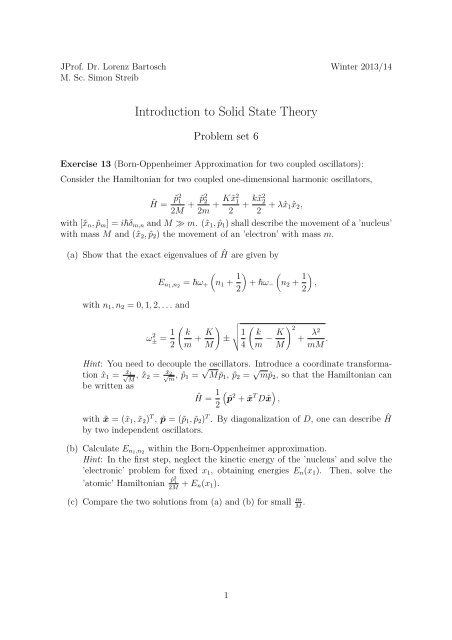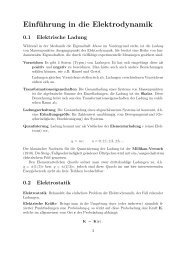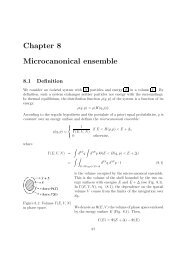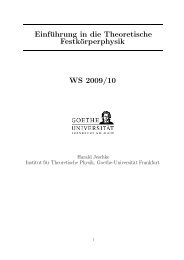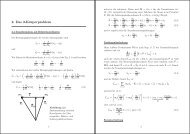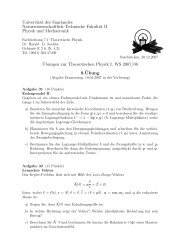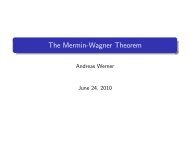Introduction to Solid State Theory
Introduction to Solid State Theory
Introduction to Solid State Theory
Create successful ePaper yourself
Turn your PDF publications into a flip-book with our unique Google optimized e-Paper software.
JProf. Dr. Lorenz Bar<strong>to</strong>sch Winter 2013/14<br />
M. Sc. Simon Streib<br />
<strong>Introduction</strong> <strong>to</strong> <strong>Solid</strong> <strong>State</strong> <strong>Theory</strong><br />
Problem set 6<br />
Exercise 13 (Born-Oppenheimer Approximation for two coupled oscilla<strong>to</strong>rs):<br />
Consider the Hamil<strong>to</strong>nian for two coupled one-dimensional harmonic oscilla<strong>to</strong>rs,<br />
Ĥ = ˆp2 1<br />
2M + ˆp2 2<br />
2m + Kˆx2 1<br />
+ kˆx2 2<br />
2 2 + λˆx 1ˆx 2 ,<br />
with [ˆx n , ˆp m ] = iδ m,n and M ≫ m. (ˆx 1 , ˆp 1 ) shall describe the movement of a ’nucleus’<br />
with mass M and (ˆx 2 , ˆp 2 ) the movement of an ’electron’ with mass m.<br />
(a) Show that the exact eigenvalues of Ĥ are given by<br />
with n 1 , n 2 = 0, 1, 2, . . . and<br />
(<br />
E n1 ,n 2<br />
= ω + n 1 + 1 ) (<br />
+ω − n 2 + 1 )<br />
,<br />
2<br />
2<br />
ω± 2 = 1 ( k<br />
2 m + K )<br />
√<br />
±<br />
1 ( k<br />
M 4 m − K M<br />
) 2<br />
+ λ2<br />
mM .<br />
Hint: You need <strong>to</strong> decouple the oscilla<strong>to</strong>rs. Introduce a coordinate transformation<br />
ˆx 1 = √ ˜x 1<br />
M<br />
, ˆx 2 = √ ˜x 2<br />
m<br />
, ˆp 1 = √ M ˜p 1 , ˆp 2 = √ m˜p 2 , so that the Hamil<strong>to</strong>nian can<br />
be written as<br />
Ĥ = 1 (<br />
˜p 2 + ˜x T D ˜x ) ,<br />
2<br />
with ˜x = (˜x 1 , ˜x 2 ) T , ˜p = (˜p 1 , ˜p 2 ) T . By diagonalization of D, one can describe Ĥ<br />
by two independent oscilla<strong>to</strong>rs.<br />
(b) Calculate E n1 ,n 2<br />
within the Born-Oppenheimer approximation.<br />
Hint: In the first step, neglect the kinetic energy of the ’nucleus’ and solve the<br />
’electronic’ problem for fixed x 1 , obtaining energies E n (x 1 ). Then, solve the<br />
’a<strong>to</strong>mic’ Hamil<strong>to</strong>nian ˆp2 1<br />
2M + E n(x 1 ).<br />
(c) Compare the two solutions from (a) and (b) for small m M .<br />
1
Exercise 14 (Primitive Vec<strong>to</strong>rs of the Reciprocal Lattice):<br />
(a) Prove that the reciprocal lattice primitive vec<strong>to</strong>rs defined by b i = 2π<br />
where (i, j, k) = (1, 2, 3) and cyclic permutations thereof, satisfy<br />
b 1 · (b 2 ×b 3 ) =<br />
(2π) 3<br />
a 1 · (a 2 ×a 3 ) .<br />
a j×a k<br />
a i·(a j ×a k ) ,<br />
Recall that v = |a 1 · (a 2 ×a 3 )| is the volume of the primitive unit cell and argue<br />
that the volume of the reciprocal lattice primitive cell is (2π) 3 /v.<br />
Hint: Write b 1 (but not b 2 and b 3 ) in terms of the a i and use the orthogonality<br />
relations b i ·a j = 2πδ ij .<br />
(b) Suppose that the primitive vec<strong>to</strong>rs are constructed from the b i in the same<br />
manner as the b i are constructed from the a i . Prove that these vec<strong>to</strong>rs are just<br />
the a i themselves; i.e., show that<br />
2π<br />
b 2 ×b 3<br />
b 1 · (b 2 ×b 3 ) = a 1,<br />
etc.<br />
Hint: Write b 3 in the numera<strong>to</strong>r (but not b 2 ) in terms of the a i , use the vec<strong>to</strong>r<br />
identity A × (B × C) = B(A · C) − C(A · B) and appeal <strong>to</strong> the orthogonality<br />
relations b i ·a j = 2πδ ij and the result in (a).<br />
Exercise 15 (Reciprocal Lattice of a Hexagonal and Trigonal Lattice):<br />
(a) Using the primitive vec<strong>to</strong>rs given by a 1 = aˆx, a 2 = (a/2)ˆx + ( √ 3a/2)ŷ, and<br />
a 3 = cẑ, show that the reciprocal of the simple hexagonal Bravais lattice is also<br />
simple hexagonal, with lattice constants 2π/c and 4π/ √ 3a, rotated through 30 ◦<br />
about the c-axis with respect <strong>to</strong> the direct lattice.<br />
(b) For what value of c/a does the ratio have the same value in both the direct and<br />
the reciprocal lattices?<br />
(c) The Bravais lattice generated by three primitive vec<strong>to</strong>rs of equal length a, making<br />
equal angles θ with one another, is known as a trigonal Bravais lattice. Show<br />
that the reciprocal of a trigonal Bravais lattice is also trigonal, with an angle θ ∗<br />
given by − cos θ ∗ = cos θ/[1 + cos θ] and a primitive vec<strong>to</strong>r length a ∗ given by<br />
a ∗ = (2π/a)(1 + 2 cos θ cos θ ∗ ) −1/2 .<br />
Course homepage: http: // www. itp. uni-frankfurt. de/ ˜ lb/ teaching<br />
2


